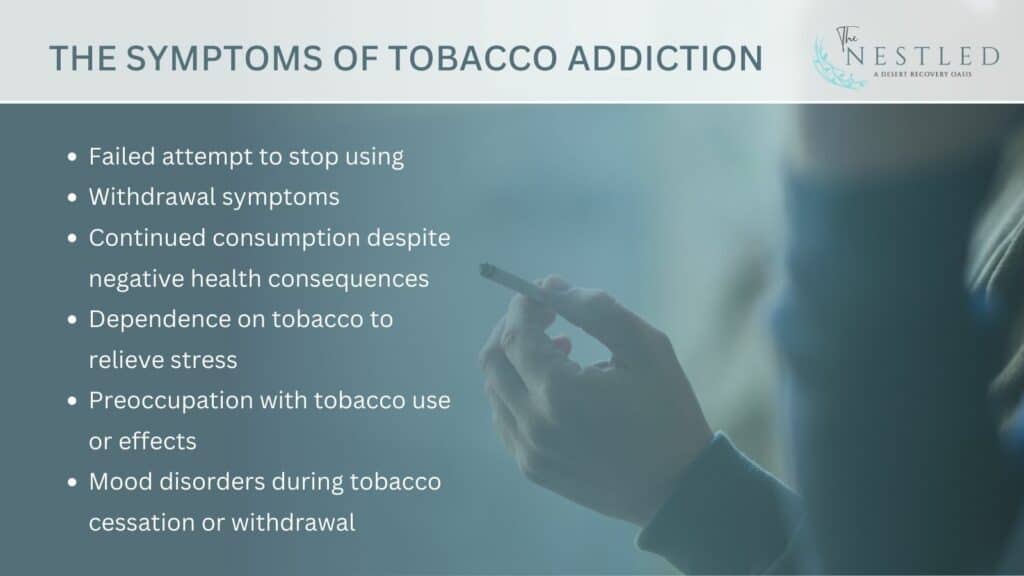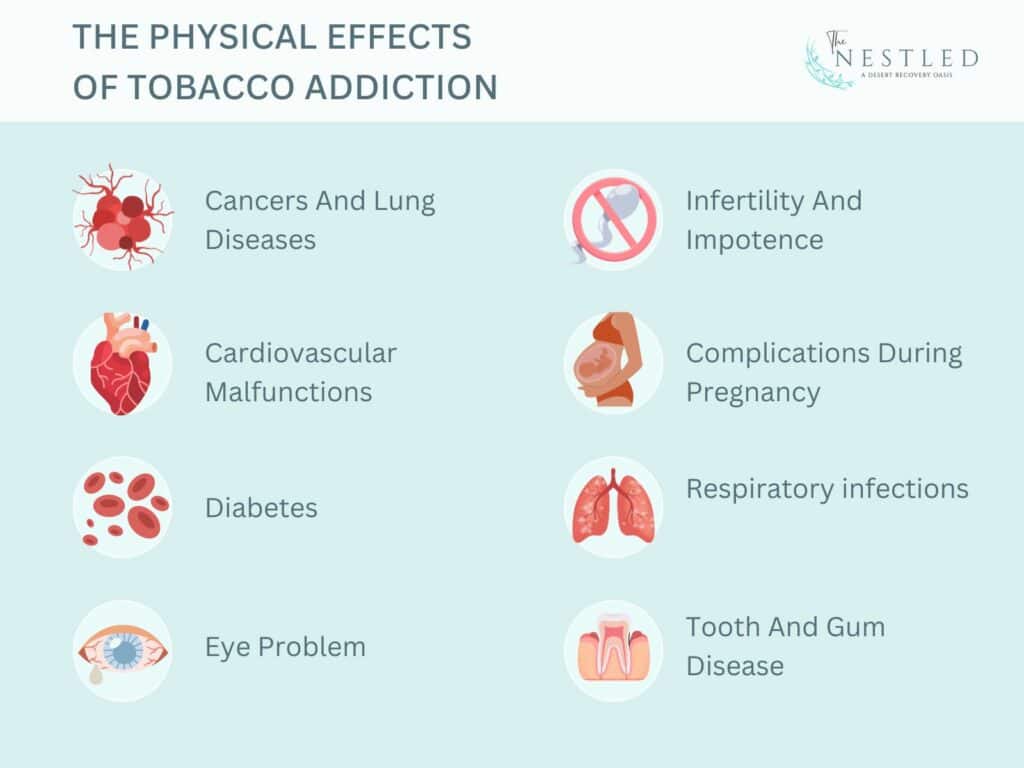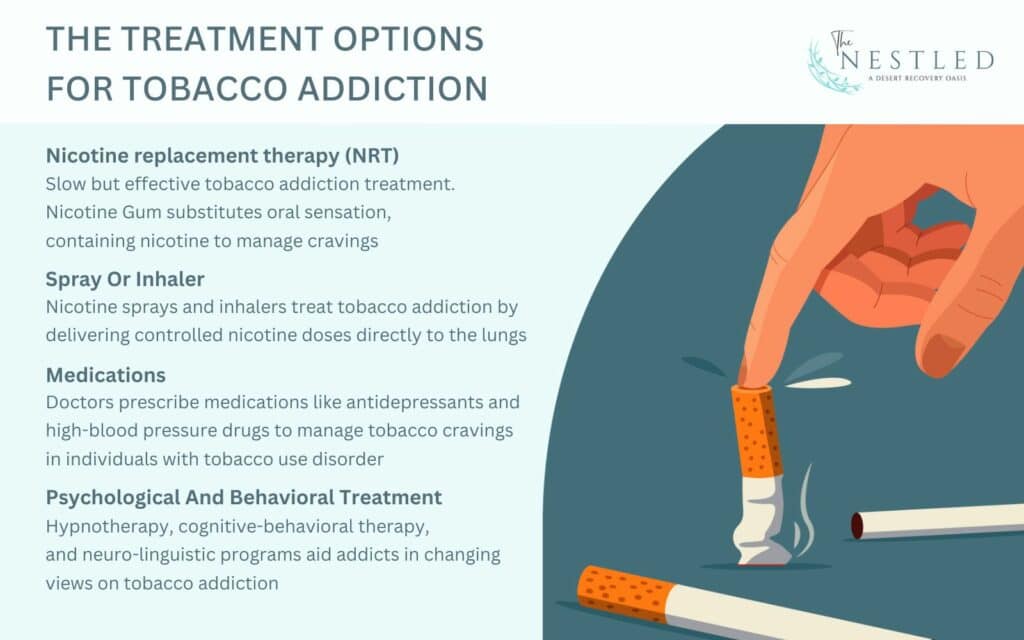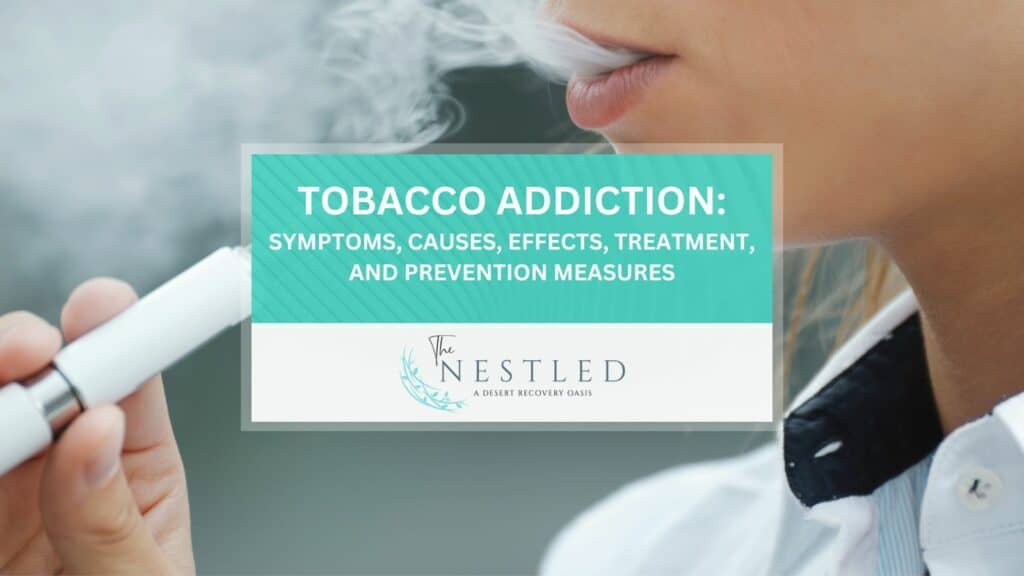Tobacco addiction is the compulsive need to use or consume any tobacco product despite the obvious risks and complications it causes to health. Tobacco affects some of the brain’s neurotransmitters, giving a feeling of relief. Data from the National Youth Tobacco Survey, 2023 shows that In 2023, 22.2% (6.21 million) of U.S. middle and high school students reported ever using any tobacco product.
The main cause of tobacco addiction is the dopamine rush and pleasurable experience people get when they use it. Apart from that, factors like genetics, stress, social and environmental settings, and tolerance also cause tobacco addiction.
The effects of tobacco addiction are serious and complicated health diseases such as lung and kidney cancer and, in many cases, death.
The best treatment for tobacco addiction is to identify why a person keeps using it, identify the reason, and deal with it first. Nicotine replacement therapy also works as professionals prescribe FDA-approved products such as gum, patches, sprays, and so on.
What Is Tobacco Addiction?
Tobacco addiction is a condition associated with the compulsive need to use or consume any tobacco product despite the obvious risks and complications it causes to health. It is mainly caused by the addictive substance of nicotine, which is the main component of tobacco leaves.
Balfour in his 2015 research, ‘The role of mesoaccumbens dopamine in nicotine dependence’ reports that nicotine, one of the chemicals found in tobacco, is the primary cause of tobacco addiction.
Nicotine increases the dopamine (happy chemical) level in the body. Dopamine takes charge of the part of the brain associated with pleasure and reward. Like any other drug, excess usage of tobacco can lead to psychological addiction. Note that the addiction can also happen through smokeless forms of tobacco, such as chewing and snuffing.
What Are The Symptoms Of Tobacco Addiction?

According to an article reviewed by Timothy J. Legg, PhD, and written by Mara Tyler for healthline on “Tobacco and Nicotine Addiction,” symptoms of tobacco addiction can include continued usage despite health problems, needing tobacco to feel normal as well as withdrawal symptoms.
Symptoms of tobacco addiction also include:
- Failed attempt to stop using
- Dependence on tobacco to relieve stress
- Preoccupation with obtaining, using, or recovering from the effects of tobacco
- Mood disorders such as depression or anxiety associated with efforts to quit tobacco or during periods without it
What Are The Causes Of Tobacco Addiction?
The causes of tobacco addiction are genetics, self-medication for mental health disorders, pleasure, use as stress relief, and influence of marketing.
In their 2005 research, ‘Metabolism and disposition kinetics of nicotine’ Hukkanen J et al report that the pharmacokinetic properties of nicotine, or the way it is processed by the body, contribute to its addictiveness.
- Pleasure: Nicotine triggers the release of dopamine, a neurotransmitter associated with pleasure and reward. The more one smokes, the more tobacco is required to achieve the same level of relief and substantial pleasure, leading to increased consumption and dependency.
- Genetic Factors: According to the American Psychological Association (APA), “at least half of a person’s susceptibility to drug or alcohol addiction can be linked to genetic factors.” These genetic factors can make certain people more likely to develop a dependence on tobacco compared to others.
- Self-Medication For Mental Health Disorders: Individuals diagnosed with mental health issues such as depression, anxiety, or attention deficit hyperactivity disorder (ADHD) are at a higher risk of becoming addicted to tobacco. The use of tobacco as a self-medication method to cope with mental health symptoms can lead to addiction, as the nicotine provides temporary relief or a sense of control over their condition.
- Tobacco Use for Stress Relief: Many people use tobacco to alleviate stress. This cycle of using tobacco to manage stress can quickly lead to addiction, as the body begins to crave nicotine to maintain these pleasurable sensations.
- Influence of Marketing and Advertising: Marketing and advertising efforts by tobacco companies contribute to tobacco addiction. These strategies often glamorize smoking and influence public perception, making tobacco use appear attractive and socially acceptable.
What Are The Effects Of Tobacco Addiction?
The ways Tobacco addiction affects its users are classified into physical effects, mental effects, and behavioral effects.
What Are The Physical Effects Of Tobacco Addiction?

A 2015 publication of the Indian Journal of Medical and Paediatric Oncology titled ‘Harmful effects of nicotine’ asserts that Nicotine is one of the most toxic of all poisons and has a rapid onset of action. Nicotine primarily affects the peripheral and central nervous systems.
In cases of severe poisoning, symptoms include tremors, prostration, cyanosis, dyspnea, convulsions, and can progress to collapse and coma.
1. Cancers And Lung Diseases
Smoking is the primary cause of lung cancer. It is also the source of lung diseases such as emphysema and chronic bronchitis.
Tobacco smoking, chewing, and snuffing also cause cancers such as mouth cancer, throat cancer (pharynx), esophagus cancer, bladder cancer, larynx cancer, cervix cancer, kidney malfunction, and different types of leukemia. According to the American Cancer Society, smoking causes approximately 30% of cancer deaths in the US.
2. Cardiovascular Malfunctions
Tobacco addiction, especially through smoking, increases the probability of dying of heart and blood vessel (cardiovascular) diseases such as heart attacks and strokes. If an individual has been diagnosed with blood vessel disease such as heart failure, smoking tobacco will complicate it even more.
3. Diabetes
Tobacco smoking increases insulin resistance, which will pave the way for type 2 diabetes to take charge. If you have been diagnosed with diabetes, tobacco addiction complicates the situation while inviting kidney disease and eye problems.
4. Eye Problem
Tobacco addiction can cause serious eye problems such as cataracts and loss of eyesight from macular degeneration.
5. Infertility And Impotence
Tobacco addiction, especially through smoking, increases infertility in women and impotence in men.
6. Complications During Pregnancy
Women who smoke while pregnant face a higher risk of birth complications or giving birth to lower birth weight babies.
7. Respiratory infections
Tobacco addiction causes respiratory infections such as colds, flu, and bronchitis.
8. Tooth And Gum Disease
Tobacco addiction is associated with inflammatory development of the gum and serious gum infection that can cripple the support system of the users’ overall dental setup.
What Are The Mental Effects Of Tobacco Addiction?
According to an article reviewed by Sabrina Felson, MD, and written by WebMD Editorial Contributor on “What to Know About Tobacco and Your Mental Health,” smoking tobacco can affect one’s mental health, but the degree of the effect depends on how much and how frequently it is consumed.
The mental effects of tobacco addiction are:
- Increased anxiety and stress
- Irritability and mood swings
- Difficulty concentrating
- Depression
- Cravings and obsession
- Decreased self-esteem
- Negative impact on relationships
What Are The Behavioral Effects Of Tobacco Addiction?
The behavioral effects of tobacco addiction are:
- Increased smoking behavior
- Spending time and money on obtaining and using tobacco products
- Persistent efforts to obtain tobacco, even in the face of adverse consequences
- Social isolation or withdrawal from activities that prohibit smoking
- Continued tobacco use despite knowing the associated health risks
- Concealing or lying about tobacco use
- Agitation or irritability when unable to smoke
- Interference with daily responsibilities or obligations due to smoking
- Legal issues related to smoking in prohibited areas or underage tobacco use.
What Are The Treatment Options For Tobacco Addiction

The National Institute on Drug Abuse (NIDA) recommends behavioral treatments such as Cognitive Behavioral Therapy, Motivational Interviewing, and mindfulness as effective approaches to treating tobacco addiction. Tobacco addiction is treated in 4 ways: NRT, inhaler, medication, and psychological treatment options.
1. NRT
This is called Nicotine replacement therapy (NRT). This process is slow but has been reported to be a better form of tobacco addiction. Nicotine Gum is another form of NRT. It is a kind of substitution for people who need the oral sensation of smoking or chewing tobacco. Addicts always feel the need to put something in their mouth; instead of tobacco, nicotine gum is produced as a perfect substitute. The gum also contains a tiny portion of nicotine to help manage the cravings.
2. Spray Or Inhaler
Nicotine sprays and inhalers are also used to treat tobacco addiction. They deliver small doses of nicotine without the tobacco. They are available in many stores. The spray goes directly to the lungs once inhaled.
3. Medications
Individuals with tobacco use disorder can also visit a doctor for prescribed medications. Some antidepressants and high-blood pressure drugs can perfectly help manage tobacco cravings. Some common medications for tobacco addiction are varenicline (Chantix) and Bupropion.
4. Psychological And Behavioral Treatment
Processes like hypnotherapy, cognitive-behavioral therapy, and neuro-linguistic programs can help addicts change their views and thoughts about tobacco addiction.
What Are The Preventive Methods Of Tobacco Addiction?
The following are the preventive measures for tobacco addiction:
1. Education and Awareness
Teaching people, especially young folks, about the health risks of tobacco is the most essential preventive measure. Most people don’t understand, but educating them about it will make a big difference in preventing them from smoking or chewing it.
2. Tobacco-free policies
Another essential preventive measure is to ban tobacco purchase or consumption in schools, workplaces, and other public places. This policy must also include restrictions on tobacco advertisement, sponsorship, and promotion.
3. Access Restrictions
This involves restricting access to tobacco products. This restriction must be particularly targeted at minors – age verification must be implemented before tobacco sales, and illegal sales of any tobacco products must be banned.
4. High prices
Increasing the cost of all tobacco sales is another essential preventive measure of tobacco addiction. High prices will reduce accessibility, especially among price-sensitive people. Not everyone has money for expensive things. The high price of tobacco will reduce purchases and subsequent consumption.
5. Community engagement
Preventing high tobacco consumption is not the responsibility of a single sector. Establish an organization that includes important stakeholders such as schools, healthcare centers, and local government in tobacco prevention activities.
How Does Tobacco Addiction Affect Pregnancy And Childbirth?
According to the National Cancer Institute, smoking doubles one’s risk of abnormal bleeding during pregnancy and delivery. This could result in premature birth, low birth weight, and a high rate of sudden infant death syndrome (SIDS).
Is Tobacco Addiction More Rampant In Certain Demographics?
Tobacco addiction affects anybody irrespective of the demography; however, some sets of people are more liable to it. For instance, an individual with a family history of smoking or someone living close to smokers faces a higher risk of getting addicted.
Where To Find Treatment For Tobacco Addiction?
Treatment for tobacco addiction is available in various settings, such as rehabilitation centers, outpatient programs, and smoking cessation clinics. Support groups like Nicotine Anonymous also offer assistance.
How To Treat Tobacco Overdose.
Immediate medical attention is necessary for tobacco overdose. Treatment may involve managing symptoms such as nausea, vomiting, and dizziness.
What Are The Different Forms Of Tobacco?
Tobacco comes in various forms, including cigarettes, cigars, pipe tobacco, chewing tobacco, and snuff.
What Are The Different Slang Names For Tobacco?
Slang names for tobacco include cigs, smokes, butts, and chew.
Where And How Is Tobacco Typically Manufactured And Produced?
Tobacco is cultivated in fields and processed in manufacturing facilities. It is often sold in various forms, including cigarettes, cigars, and smokeless tobacco products.
How does tobacco addiction interact with Ambien addiction in terms of symptoms and treatment approaches?
Tobacco addiction and Ambien addiction can interact in complex ways, exacerbating symptoms and complicating treatment approaches. Tobacco use can intensify the sedative effects of Ambien, leading to increased drowsiness, impaired cognitive function, and higher risk of accidents. Furthermore, the withdrawal symptoms from both substances can overlap, causing heightened anxiety, irritability, and sleep disturbances. Treating co-occurring addictions requires a comprehensive plan that addresses both dependencies simultaneously. Behavioral therapies, such as cognitive-behavioral therapy (CBT), can be effective in addressing the psychological aspects of addiction, while medical supervision may be necessary to manage withdrawal symptoms safely and effectively.
Can tobacco use increase the risk of developing an addiction to substances like ketamine, and how should treatment be adjusted?
Tobacco use can potentially increase the risk of developing an addiction to other substances like ketamine. Nicotine and other substances often share common pathways in the brain’s reward system, making users more susceptible to multiple addictions. The presence of nicotine addiction can lower inhibitions and increase the likelihood of experimenting with other drugs. When treating individuals with co-occurring addictions to tobacco and ketamine, it is crucial to adopt a dual-diagnosis approach. This involves integrating treatments that address both nicotine dependence and ketamine addiction, such as combined use of nicotine replacement therapy and behavioral interventions tailored to treat substance use disorders.
What are the long-term effects of combining tobacco with prescription medications like Ambien and ketamine, and how can these effects be mitigated?
Combining tobacco with prescription medications like Ambien and ketamine can lead to significant long-term health effects. Nicotine can alter the metabolism of these medications, potentially reducing their efficacy or increasing the risk of adverse side effects. For instance, tobacco use may enhance the sedative effects of Ambien, leading to increased risks of falls and cognitive impairment. Similarly, combining tobacco with ketamine can heighten cardiovascular risks and exacerbate respiratory issues.
What Are The Law Enforcement Efforts And Legal Implications Of Tobacco?
Law enforcement enforces regulations on tobacco sales to minors, taxation, and restrictions on smoking in public places. Legal implications for violating tobacco laws may include fines and penalties.
What Is The Role Of Law Enforcement Agencies In Stopping Tobacco Distribution And Use?
Law enforcement agencies enforce tobacco control policies, conduct sting operations to prevent illegal sales and educate the public about the risks of tobacco use.
What Are The Drug Control Policies And Implications For Tobacco?
Tobacco is regulated by various laws and policies aimed at reducing its use and promoting public health. These include taxation, advertising restrictions, and smoke-free laws.
What Are The Legal Consequences For Using And Selling Tobacco?
Legal consequences for violating tobacco laws may include fines, penalties, and restrictions on tobacco sales licenses.
How Are The Effects Of Tobacco Addiction And Other Drug Addiction Different Or Similar?
Tobacco addiction is primarily characterized by physical dependence on nicotine, whereas other drug addictions may involve dependence on different substances with varying effects. However, both tobacco addiction and other drug addictions can lead to negative health outcomes and social consequences.

Share This Post




